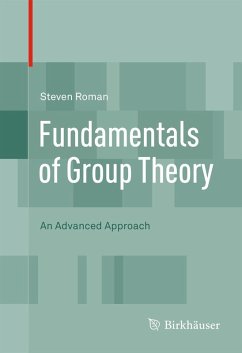Fundamentals of Group Theory provides an advanced look at the basic theory of groups. Standard topics in the field are covered alongside a great deal of unique content. There is an emphasis on universality when discussing the isomorphism theorems, quotient groups and free groups as well as a focus on the role of applying certain operations, such as intersection, lifting and quotient to a "group extension". Certain concepts, such as subnormality, group actions and chain conditions are introduced perhaps a bit earlier than in other texts at this level, in the hopes that the reader would acclimate to these concepts earlier.
Some additional features of the work include:
A discussion of the Sylow subgroups of the symmetric group in terms of wreath products. An introduction to the techniques used to characterize finite simple groups. Birkhoff's theorem on equational classes and relative freeness. This book is suitable for a graduate course in group theory, part of a graduate course in abstract algebra or for independent study. It can also be read by advanced undergraduates. The book assumes no specific background in group theory, but does assume some level of mathematical sophistication on the part of the reader.
Some additional features of the work include:
- An historical look at how Galois viewed groups.
- The problem of whether the commutator subgroup of a group is the same as the set of commutators of the group, including an example of when this is not the case.
- The subnormal join property, that is, the property that the join of two subnormal subgroups is subnormal.
- Cancellation in direct sums.
- A complete proof of the theorem of Baer characterizing nonabelian groups with the property that all of their subgroups are normal.
- >2) or else cyclic or generalized quaternion (for p=2) and the nature of gro
Dieser Download kann aus rechtlichen Gründen nur mit Rechnungsadresse in A, B, BG, CY, CZ, D, DK, EW, E, FIN, F, GR, HR, H, IRL, I, LT, L, LR, M, NL, PL, P, R, S, SLO, SK ausgeliefert werden.
"This is an introductory textbook on group theory which covers its fundamentals in great detail. ... What distinguishes the treatment of group theory from that usually given in algebra textbooks is the very detailed presentation. ... This charming volume has much to recommend itself." (Monatshefte für Mathematik, 2015)
"This is a text aimed at graduate students. Its 350 pages or so cover more than enough to teach a year-long course on 'general group theory' (meaning here both finite and infinite groups). Most standard topics are covered ... in a fresh manner, by insisting on lesser known aspects and by providing newer, more elegant proofs. An adequate collection of proposed exercises comes at the end of each chapter ... ." (Marian Deaconescu, Zentralblatt MATH, Vol. 1244, 2012)
"This is a text aimed at graduate students. Its 350 pages or so cover more than enough to teach a year-long course on 'general group theory' (meaning here both finite and infinite groups). Most standard topics are covered ... in a fresh manner, by insisting on lesser known aspects and by providing newer, more elegant proofs. An adequate collection of proposed exercises comes at the end of each chapter ... ." (Marian Deaconescu, Zentralblatt MATH, Vol. 1244, 2012)
From the reviews: "This is a text aimed at graduate students. Its 350 pages or so cover more than enough to teach a year-long course on 'general group theory' (meaning here both finite and infinite groups). Most standard topics are covered ... in a fresh manner, by insisting on lesser known aspects and by providing newer, more elegant proofs. An adequate collection of proposed exercises comes at the end of each chapter ... ." (Marian Deaconescu, Zentralblatt MATH, Vol. 1244, 2012)

